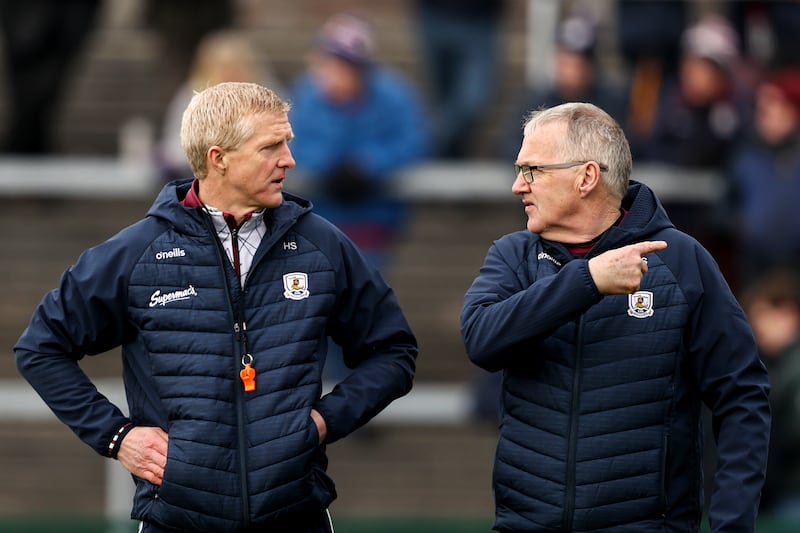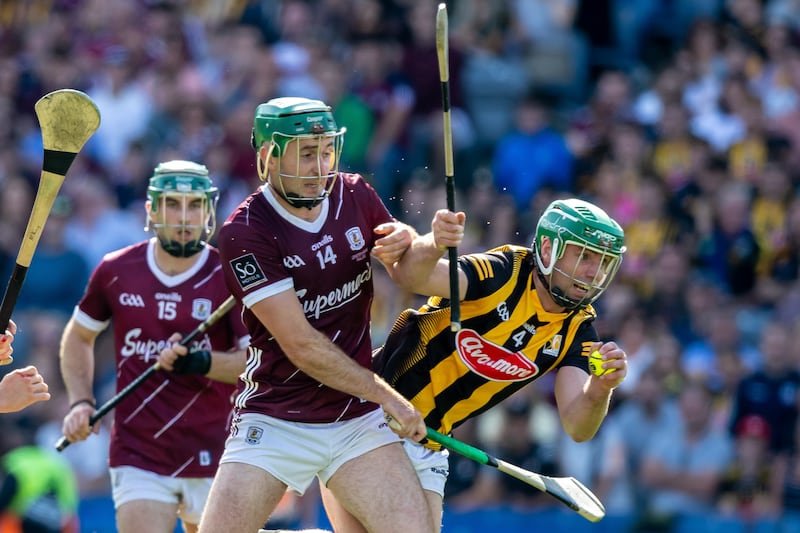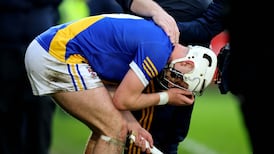Shortly after the All-Ireland semi-final last July, Henry Shefflin was hauled in front of a leading question.
He was asked to reflect on the year, which for a losing manager is an invitation to perform a hot wash in public. Halfway through the question there was an audible sigh. Shefflin knew the drill. The verdict was in. Outright denials were futile.
In the middle of his response he said, bluntly, that “it just feels like this year wasn’t good”. He tried briefly to change the trajectory of the answer, claiming that there had been “more patches of good play” than the year before; the first 20 minutes against Limerick, he said, had been “very good”.
But that just led him to an unavoidable concession. “It is just – I hate using the word – the inconsistency of that was hurting us.” Twenty minutes of “very good” play against Limerick was like holding a cocktail umbrella in a storm.
READ MORE
In his first two seasons, what difference had Shefflin made? Galway’s destructive relationship with inconsistency had preceded him and sent a litany of Galway managers around the twist. He didn’t bring the disease and he hadn’t brought the cure.
His mission was to win All-Irelands which meant, among other things, not getting lost in Limerick’s maze. They led the All-Ireland champions by six points 10 minutes before half-time in Croke Park last July and ended up losing by nine. They had flunked one or two other tests during the year too, but in a sense, they were mocks.
What did Galway look like now? Did they have an identity? A discernible style of play?
It is a hard-baked fallacy that any team would be shaped in the image of their manager, but Shefflin is one of the greatest forwards that ever lived, and Galway’s forward play was sometimes clunky or clouded. The assumption was that there must be a signal failure, or a breakdown in transmission.
“There was no clean, crisp ball going into [Conor] Whelan, or the other forwards,” wrote Joe Canning in his Irish Times column, after Galway scored just three points in the last 24 minutes of the 2022 Leinster final.
“I could see no pattern to their attacking play,” wrote Canning after last year’s Leinster final. “If I had been playing on the inside line, I wouldn’t have known what runs to make. I wouldn’t have known what kind of ball was coming in, or if it was going to come in.”
Shefflin was still a young manager and this was his first brush with failure. In his only two seasons in charge of his home club Ballyhale Shamrocks they won back-to-back All-Irelands. His single season as manager of Thomastown in the Kilkenny intermediate championship ended in disappointment, but a setback like that will have very few ripples.
This was the first real test of Shefflin as a manager. In his two years in charge they had lost successive Leinster finals to Kilkenny and successive All-Ireland semi-finals to Limerick. Whoever the manager was, these were the matches that would define Galway’s season in any year. He needed to identify solutions. And act.
At the end of last year he made consequential changes. Johnny O’Connor, the former rugby international, was appointed as their new athletic lead and Shefflin persuaded Eamon O’Shea to join his coaching team. Both appointments had the potential to be transformative, but acquiring the services of O’Shea was a stone-cold coup.
He had been living and working in Galway for decades, in plain sight and out of reach. Sitting in the stand in Pearse Stadium you can see his house in Glenard, overlooking the ground. His son Donal won a minor All-Ireland with Galway and is part of the senior panel now. Salthill-Knocknacarra GAA club was the home that O’Shea had made away from home. But this was the first time he had bent to Galway’s wishes.
“There was never any formal involvement,” says Paul Bellew, the Galway chair. “He would have come in and done a session or two at different levels – even up to senior level – over the years, but never formally involved. He was always someone we were eager to have involved and there obviously would have been plenty of approaches and discussions over the years but getting him into the senior set-up was 100 per cent Henry’s idea. Henry pushed it.”

It is early days, and O’Shea’s methods take time. For the players his training sessions are immersive experiences. He doesn’t stand to the side, he conducts from the middle.
James Skehill, the former Galway goalkeeper, is involved with the Galway U-20s now and has watched some of O’Shea’s sessions.
“He brings so much energy to training that you can do nothing but react to him. He has so much energy you’re going to follow him. He’s very loud on the training field, he’s a hundred words a minute. He’s telling you where to go and what to do. Brilliant.”
O’Shea is not a whiteboard coach, he doesn’t do drills, he doesn’t coach by prescription. In a 2010 interview with Sliotar, the sadly departed online hurling magazine, O’Shea tried to explain the abstraction at the heart of his vision.
“This goes deeper,” he said. “This goes to the soul, if it exists. It’s deeper than simply the physical aspect. This has to flow. You need to feel the confidence, the self-assuredness running through you. Then, that takes over.”

The Galway players will need to embrace O’Shea with an open mind and be patient. Noel Lane, the former Galway player and manager, has seen O’Shea giving coaching clinics in clubs and he was as entranced as everybody else.
“He just thinks differently,” says Lane. “He looks at a macro level and sees things differently. It’s not easy for players maybe to comprehend and fully understand Eamon because he thinks at a very high level. It’s not always that easy to understand his systems but I was very impressed with him.”
For Galway’s attack to flourish, though, other fundamentals must be in place. When they lost the All-Ireland semi-final last July Limerick dominated them in the air in the second half. Against Dublin last Sunday, says Lane, Galway were “poor in winning primary possession”.
When they lost to Tipperary in Thurles last month, says Bellew, “we maybe struggled on primary possession. We tend to score highly, but we need to get our hands on more ball”.
Johnny Glynn’s appearance at a Galway training session last week feeds into that narrative. For the last six years Glynn has spent most of his time in the United States, and when he started in the 2018 All-Ireland final against Limerick he had only come home a few weeks earlier. Croke Park was a playground for giants that day but Glynn led the tale of the tape: he togged out at 6ft5in and 15½ stone, bigger even than Gearóid Hegarty. His catching hand is like the bucket of a JCB.
Is he on board for the season? No decision has been made by either party. On Sunday, when Galway played Dublin, he lined out for Ardrahan in a challenge match against Patrickswell. He came home for last year’s Galway championship and was outstanding.

“He had an unbelievable campaign,” says Bellew. “If he was in the country, it wouldn’t even be a debate [to bring him back]. Henry is exploring the option. How will he go five years after last playing an inter county match? That’s the big question. That’s the only question. That’s why Henry has been very clear, he’s not officially on the panel yet. He’s going to come in and he’s going to see how he goes.
“For people that don’t know him, Johnny is a very mature, straight-talking fellah. If Johnny doesn’t feel it’s for him, Johnny will be telling you before he’s told. That’s why this is an easy one for us to go with.”
At the end of 2021 Shefflin inherited the oldest squad in the hurling championship. Seven thirtysomethings had been in the hunt for a starting place in Shane O’Neill’s last season, which was more than any other team in the top tier. If Glynn returns to the panel, eight thirtysomethings will be in the picture this year: Padraic Mannion, Daithí Burke, Joseph Cooney, Conor Cooney, David Burke, Adrian Tuohey, Gearóid McInerney and Glynn.
In the 29 tortuous years between Galway’s last All-Ireland and their second last, changing the team was too often championed as the off-the-peg solution. Because Galway had such a bountiful supply of young talent the temptation seemed to be irresistible.
That metabolism has slowed. Galway won four All-Ireland minor titles in a row between 2017 and 2020, and maybe only three graduates from those teams will be championship players for Galway this summer; eight of them have been given some game time in the league this year, so far. It sounds like a modest number.
“The minor piece will always be a stick to beat us,” says Bellew. “We’ve identified things internally whereby, physically, we could have been doing more earlier to get people through. There was a bit of feedback from previous managements that people weren’t coming through ready [from age-grade teams], and it was taking that bit longer in the system. We think we have rectified that. You are beginning to see new faces breaking through but it does take time. I’m not overly concerned about that.”
Limerick are in town today. Something will be learned. Nothing declared. O’Shea’s last great project with Tipp was to find a way around the All-Ireland champions. For 35 minutes in the 2021 Munster final they managed it. Not nearly long enough. Unfinished business. Still thinking.
O’Shea represents Shefflin’s best chance. He knows that. Smart move.
- Listen to our Inside Politics Podcast for the latest analysis and chat
- Sign up for push alerts and have the best news, analysis and comment delivered directly to your phone
- Find The Irish Times on WhatsApp and stay up to date













